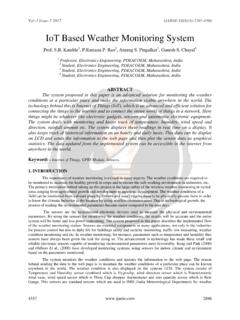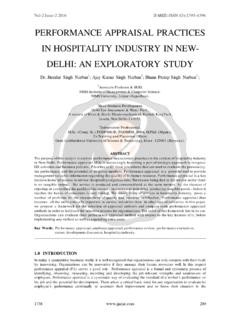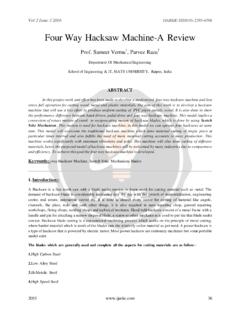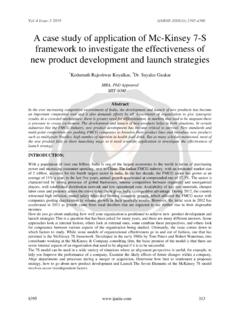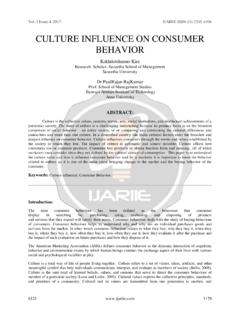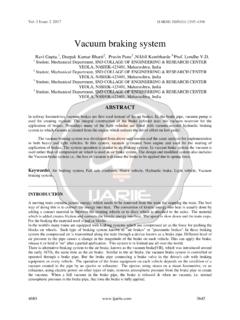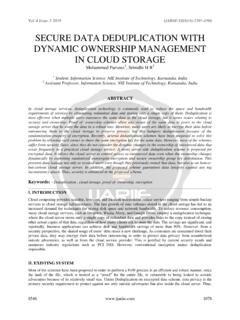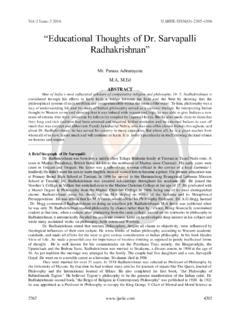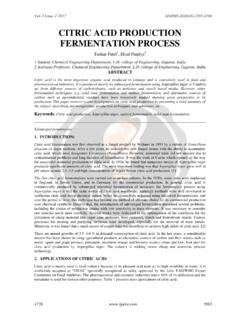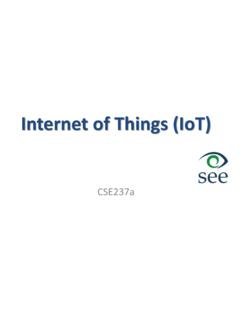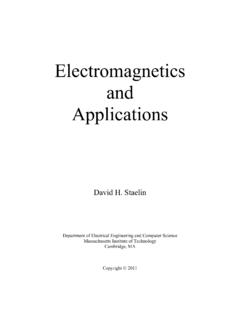Transcription of BIOSENSORS: PRINCIPLE, TYPES AND APPLICATIONS
1 Vol-3 Issue-2 2017 IJARIIE-ISSN(O)-2395-4396 4676 3639 BIOSENSORS: PRINCIPLE, TYPES AND APPLICATIONS Shagun Malhotra1, Abhishek Verma2, Naveen Tyagi3, Vivek Kumar4 1 Electronics Design Engineer (R&D Deptt.), Vinytics Peripherals Pvt. Ltd, New Delhi, India 2 Senior Design Consultant (R&D Deptt.), Vinytics Peripherals Pvt. Ltd, New Delhi, India 3 Assistant Professor (ECE Deptt.), Maharaja Agrasen University, Himachal Pradesh, India 4 Assistant Professor (EEE Deptt.), HMR Institute of Technology & Management, Guru Gobind Singh Indraprastha University, New Delhi, India ABSTRACT Biosensors are the device in which there is a coupling of biological sensing element with a detector system using a transducer.
2 In comparison with any other currently available diagnostic device, biosensors are much higher in performance in terms of sensitivity and selectivity both. Biosensors have found potential APPLICATIONS in the industrial processing and monitoring, environmental pollution control, also in agricultural and food industries. Important features for commercialization of the biosensors are selectivity, sensitivity, stability, reproducibility and low cost. This article reviews the brief history, basic principles, and the various TYPES of biosensors available.
3 Keyword: - Biosensors, Principle, TYPES and APPLICATIONS . 1. INTRODUCTION A biosensor is an analytical device which converts a biological response into an electrical signal (Fig. 1). The term 'biosensor' is often used to cover sensor devices used in order to determine the concentration of substances and other parameters of biological interest even where they do not utilize a biological system directly. Biosensors function by coupling a biological sensing element with a detector system using a transducer. The first scientifically proposed as well as successfully commercialized biosensors were electrochemical sensors for multiple analytes.
4 The following statement is also defined for the biosensor, A chemical sensing device in which a biologically derived recognition is coupled to a transducer, to allow the quantitative development of some complex biochemical parameter. The Schematic diagram shown below for the biosensor is mainly divided into three sections. (i) sensor : a sensitive biological element (biological material (eg. tissue, microorganisms, organelles, cell receptors, enzymes, antibodies, nucleic acids, etc), (ii) Transducer: it is the detector element (works in a physicochemical way; optical, piezoelectric, electrochemical, etc.))
5 That transforms the signal resulting from the interaction of the analyte with the biological responsible for the display of the results in a user-friendly way, (iii) third section is the associated electronics, which comprises of signal conditioning circuit (amplifier), processor and a display unit. Fig -1: Schematic diagram showing main components of a biosensor Vol-3 Issue-2 2017 IJARIIE-ISSN(O)-2395-4396 4676 3640 Principle of a Biosensor The desired biological material (usually a specific enzyme) is immobilized by conventional methods (physical or membrane entrapment, non- covalent or covalent binding).
6 This immobilized biological material is in intimate contact with the transducer. The analyte binds to the biological material to form a bound analyte which in turn produces the electronic response that can be measured. In some instances, the analyte is converted to a product which may be associated with the release of heat, gas (oxygen), electrons or hydrogen ions. The transducer can convert the product linked changes into electrical signals which can be amplified and measured.
7 Fig -2: Measurement flow for a biosensor Working of a Biosensor The electrical signal from the transducer is often low and superimposed upon a relatively high and noisy ( containing a high frequency signal component of an apparently random nature, due to electrical interference or generated within the electronic components of the transducer) baseline. The signal processing normally involves subtracting a 'reference' baseline signal, derived from a similar transducer without any biocatalyst membrane, from the sample signal, amplifying the resultant signal difference and electronically filtering (smoothing) out the unwanted signal noise.
8 The relatively slow nature of the biosensor response considerably eases the problem of electrical noise filtration. The analogue signal produced at this stage may be output directly but is usually converted to a digital signal and passed to a microprocessor stage where the data is processed, manipulated to desired units and output to a display device or data store. 2. GROWTH OF THE BIOSENSORS TECHNOLOGY There are mainly three so-called 'generations' of biosensors; First generation biosensors where the normal product of the reaction diffuses to the transducer and causes the electrical response, second generation biosensors which involve specific 'mediators' between the reaction and the transducer in order to generate improved response, and third generation biosensors where the reaction itself causes the response and no product or mediator diffusion is directly involved.
9 The development of biosensors began in 1950, when L. L. Clark develops biosensors with an oxygen electrode (popularly known as Clark electrode) in Cincinnati, USA to measure the dissolved oxygen in blood. Later, glucose oxidase enzyme in a gel was coated and immobilized on the oxygen electrode to measure blood sugar. Similarly, enzyme urease was used in combination with an electrode was developed which was specific for NH4++ions for measuring urea in body fluids like blood and urine. [1] Vol-3 Issue-2 2017 IJARIIE-ISSN(O)-2395-4396 4676 3641 There are initially two following TYPES of transducer technologies.
10 In the first one, the estimates were made by measurement of electric current (amperometric) and in the second case for urea measurements, the estimates were based on the measurement of charge on the electrode (potentiometric). The biosensors based on the use of enzymes involving catalytic action are described as catalytic biosensors as against bioaffinity biosensors developed later, which do not make use of enzymes, but instead make use of antibodies, receptor molecules, etc., which have high affinity with the analyte.
